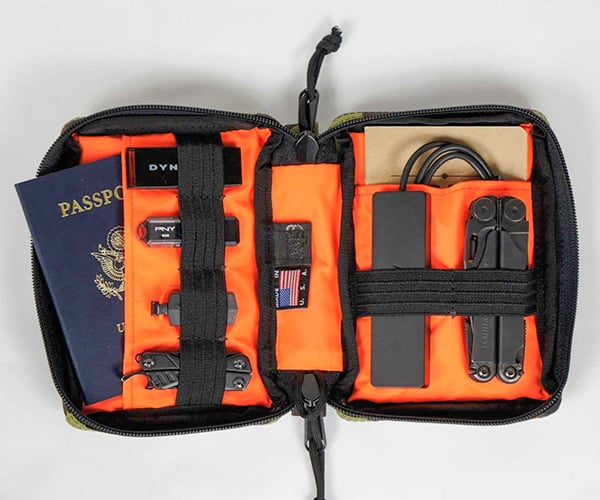Built from the ground up, with variants for React, Vue, and Livewire, the brand new Laravel starter…Laracasts
This Is By Far My Favorite Way to Organize Photos on My Computer
https://static1.makeuseofimages.com/wordpress/wp-content/uploads/2025/02/adobe-bridge-on-a-computer.jpeg
Organizing photos on a computer can be tedious, but Adobe Bridge makes it much easier. Thanks to its simplified filtering and seamless integration with other Adobe apps, the tool is by far the best of its kind.
How I Organize My Photos With Adobe Bridge
I’ve become much stricter with pictures I edit since becoming an intermediate photographer (and even moving beyond that stage). I use multiple Adobe Bridge features to organize my files and select which images make the cut.
1. Creating Libraries
Creating libraries in Adobe Bridge helps me segment images based on their correct location. I sometimes use this feature to divide pictures by the month I took them, but I’ll also create libraries based on the articles I’ll use the photos in.
If you want to level up your travel photography, I recommend making new libraries based on each trip. You can segment this down even further by creating new ones for different days.
You can choose from preset names or start from scratch when creating libraries in Adobe Bridge.
2. Using the Star Rating System
Vetting my pictures before importing them into an app is one of the best ways I accelerate my photo editing workflow. Adobe Bridge lets me rate my images from 1-5 stars, and my workflow here is quite simple.
If I know with certainty that I want to edit a picture, I’ll rate it five stars. On the other hand, I’ll rate pictures as three stars if I’m on the fence and would like to revisit them later.
I rate social media pictures as four stars to differentiate between images I use on social media and those that appear elsewhere. After clicking on a picture in Adobe Bridge, the stars automatically appear.
3. Rejecting Photos I Won’t Use
I automatically reject any photos that I know I won’t use. Most of the time, I reserve this tool for blurry images, bad lighting, and compositions that I don’t like.
Sometimes, I keep different variations of the same shot; this is usually when I’ve used different apertures. However, if every image is the same, I’ll keep one and discard the rest.
I tap the circle icon with a diagonal line to reject an image.
4. Using Filters
I can access rejected images by selecting the Show Rejected Items Only filter. It’s also possible to only show pictures based on their star rating, which is useful when I’m undecided on some photos. After looking at them again, I often know whether I want to edit them.
Adobe Bridge has tools to sort pictures by keywords, date created, and other metrics. Sorting by keywords is helpful if I want to organize photos by category (e.g., food or architecture).
Why I Love Organizing My Photos With Adobe Bridge
I could use many Adobe Bridge features in other apps, but Bridge is still my number one choice for multiple reasons.
I Can Delete SD Card Files More Efficiently
Keeping my SD card organized is even more important than sorting out the files on my computer. I don’t like deleting files on my camera unless I’m formatting because it’s slow and inefficient.
Adobe Bridge is the simplest solution I’ve found so far. I can hit the backspace key when I don’t like an image to remove it. I sometimes drag my cursor to highlight all images before removing them, which, again, is quite simple.
Related
Buying an SD card can feel challenging. Here’s how to choose the right SD card for your device.
I Can Seamlessly Work With Other Adobe Apps
Although you can use Adobe Bridge without Photoshop or Lightroom, the tool works very well with both. For example, I can open any picture in Photoshop by simply double-clicking on it in Bridge.
Adobe Bridge also has a feature that lets you open an image in Camera Raw. From here, you can make your desired adjustments.
It’s Easier to Navigate
Even if another app had all the same features as Adobe Bridge, I still wouldn’t use it unless navigation was easier. I have never enjoyed navigating other photo organization tools because they’ve always felt clunky.
Bridge, by comparison, is pretty sleek. Regardless of how many images I need to sift through, I’ve never had problems with the app crashing. Moreover, I enjoy having multiple controls over how everything looks. For example, I can change how thumbnails look.
There is, admittedly, an initial learning curve. Nonetheless, it’s much smaller than other apps.
I Can Create Sequences and Workflows
Creating custom workflows is one of my secret sauces for organizing images more effectively in Adobe Bridge. The app lets me build sequences based on batch renaming, changing the image format, resizing, and applying metadata.
I don’t need to use all of these features each time, but they’re helpful if I have many of the same types of pictures. For example, if I’ve been on a trip, I might segment my metadata based on the region.
Resizing, meanwhile, is helpful when I plan to upload my images on Instagram. Bridge lets me choose how much I want to scale/resize the picture for more optimal results. After making my custom workflow, I can save and name it based on the necessary parameters.
Multiple Views for Effective Management
Having too many views can be confusing, but Adobe Bridge strikes a good balance. I can easily see my images, the other pictures saved in the same place, areas for metadata, and more.
I can resize panels based on what I think is the most important, along with undocking and removing if needed. Adobe Bridge also lets you add new tabs within certain areas if required.
Since I can see multiple elements in one place, making my preferred changes is much simpler. I can easily fill out an image’s metadata without needing to click on a different screen, for example.
Even if I didn’t use other Adobe apps, I’d still organize my photos with Bridge. It’s the perfect place to edit folders on my computer, hard drive, and camera SD card. I like how I don’t need to context-switch while working, and the app has numerous features that make choosing and deleting images easier.
MakeUseOf
ArcaOS (OS/2 Warp OEM) 5.1.1 Has Been Released
"IBM stopped supporting OS/2 at the end of 2006," write the makers of ArcaOS, an OEM distribution of OS/2’s discontinued Warp operating system. And now long-time Slashdot reader martiniturbide tells us that ArcaOS 5.1.1 has been released, and that many of it’s components have been updated too. From this week’s announcement:
ArcaOS 5.1.1 continues to support installation on the latest generation of UEFI-based systems, as well as the ability to install to GPT-based disk layouts. This enables ArcaOS 5.1.1 to install on a wide array of modern hardware. Of course, ArcaOS 5.1.1 is just as much at home on traditional BIOS-based systems, offering enhanced stability and performance across both environments…. Need more convincing? How about a commercial operating system which doesn’t spy on you, does not report your online activity to anyone, and gives you complete freedom to choose the applications you want to use, however you want to use them? How about an operating system which isn’t tied to any specific hardware manufacturer, allowing you to choose the platform which is right for you, and fits perfectly well in systems with less than 4GB of memory or even virtual machines?
Read more of this story at Slashdot.
Slashdot
This German doctor teaching his colleagues how to fight off knife attackers with TOWELS is amazingly on-brand and I can’t stop laughing
https://media.notthebee.com/articles/67b4e1e46fec767b4e1e46fec8.jpg
Are you looking to keep the blood in your body while mostly-peaceful people attack you? Boy do I have the class for you!
Not the Bee
Pyro Putty
https://theawesomer.com/photos/2019/11/pyro_putty_2021_t.jpg
Between the wind, cold, and damp conditions, getting outdoor fires started can be challenging. This moldable putty can be stuck to logs, torches, or tinder, and will burn for up to 15 minutes with just a quarter-sized dab, giving your fire a fighting chance. It comes in blends for various climates and applications.
The Awesomer
How to Do a Museum
https://content.artofmanliness.com/uploads/2025/01/mus.jpg

Over the Christmas break, our family took a trip to New York City. While we were there, we visited two of NYC’s most famous museums: the Metropolitan Museum of Art and the Museum of Natural History.
We had a great time but found the experience pretty overwhelming. There’s a lot of great art and exhibits in these museums, and they’re freaking huge. After spending a couple of hours at each museum, we were all pooped, though we hadn’t even scratched the surface of these cultural institutions.
It got me wondering if I could improve my approach to visiting a museum. What was the best way to do one?
I knew just who to ask to get the answer to that question: Nick Gray. Nick was on the AoM podcast a couple of years ago to discuss his book The 2-Hour Cocktail Party. Besides encouraging people to host short cocktail parties, he’s spent part of his career as a private museum tour guide in New York City and has led hundreds of tours. The man is passionate about museums. One of his life’s slogans is: “Museums are F***ing Awesome.”
I hopped on the horn with Nick to get tips on how to get the most out of your next museum visit. Here’s his field-tested battle plan.
Preparing for Your Museum Visit
Download the museum’s app. Nick told me that most big museums these days have their own app that you can use to enhance your visit, so check if they have one before you arrive. Many of these apps provide interactive maps as well as self-paced tours right on your phone. For example, the Museum of Natural History’s app has a map that can help you navigate its 1.2 million square feet. This would have come in handy on our visit; we got lost trying to find our way from the space section of the museum to its human history area.
Consider joining a tour group (but don’t be afraid to ditch it). I asked Nick if he recommended signing up for a guided tour at a museum. He told me that guided tours can make the experience more enjoyable, but he did provide this surprising caveat: “If you decide to join an in-person guided tour, you need to think about it like a magazine. Just like you can pick up a magazine and put it down without finishing it, you don’t need to stay with a tour for the entire time. Feel free to leave that tour if it’s no longer serving you.”
Nick did advise that you should leave with tact and grace. Just sort of fade away without making a big scene of it. Like an Irish goodbye.
Pack like you’re going on a day hike. A museum visit is more physically demanding than most people realize. You’re going to walk about two miles during a typical two-hour visit at a large museum. One of the biggest mistakes Nick sees people make is underpacking for their visit. He recommends you gear up for a museum visit like you would for a day hike or a trip to an amusement park. His essential packing list:
- Comfortable shoes
- Water bottle
- Light snack
- Headphones (for audio tours from your phone)
- Light layers (museums are climate-controlled and often chilly)
Nick especially emphasized the importance of bringing some snacks like nuts or a granola bar on your museum visit. “There’s an actual known phenomenon called ‘gallery fatigue’ where you just feel really wiped out mentally and physically from looking at exhibits,” Nick told me. Gallery fatigue seems to be caused by a combination of walking a lot and your brain having to choose what to pay attention to and process an endless stream of novel stimuli. Nick always kept snacks on hand for the folks in his tour groups to help stave off this condition.
Arriving at the Museum
Beat the crowds. If you’re looking to avoid the crowds, Nick recommends not visiting museums on Sunday afternoons (especially rainy and cold ones). That’s when museums are the busiest.
If you want to visit a museum when it’s less crowded, Nick suggests arriving when the museum first opens, but with this caveat: “Get there about 20-30 minutes after the museum opens. If you get there right when it opens, you’ll be standing in a long line, but usually 20 minutes after opening up, that line is gone.”
Don’t look at the exhibits (at first). Once you’re inside the museum, the first thing Nick counterintuitively recommends is to NOT look at the art. Instead, you’re going to do this:
- Get a map from the front desk.
- Walk the entire floor plan of the museum without stopping.
- Keep moving even when interesting pieces catch your eye. Don’t read any wall text or take photos.
- Complete this initial walkthrough in 10-30 minutes.
This quick initial walkthrough will give you a mental map of the museum, which will help you plan the rest of your visit.
Nick did have a caveat to his initial walkthrough advice: “For large museums like the Met or the Louvre, even a quick walkthrough would take an hour and a half, so don’t do this for those types of museums. This strategy is great for medium-sized museums.”
Take a short break and plan your visit. After your walkthrough, head to the café and have a seat to recharge for a bit. During this time, have a drink and a snack. Study your map and plan which galleries you want to revisit and spend more time in.
When planning, Nick recommends focusing on eliminating things you won’t see. If there’s a type of art or an era in history that doesn’t interest you, don’t visit that wing. It’s okay to not like or be interested in certain things.
Also, Nick recommends avoiding special exhibits: “If you’re just visiting for the day, don’t waste your time with special exhibits. These are better for locals who can come to the museum regularly. If you’re on vacation and only have two hours to visit a museum, stick to the permanent section highlights.”
Download an audio tour. Once you’ve winnowed down what you want to see on your visit, Nick recommends downloading an audio tour to your smartphone. They’re a great way to stay engaged on your visit and learn more about exhibits than you would wandering around on your own.
As mentioned above, many museum apps have these pre-loaded. Nick also told me that Bloomberg Philanthropies offers free and very well-done audio tours for your phone for many of the big museums in the United States and even a few in other countries.
If you’re visiting the Met, Nick recommends Bloomberg’s “Highlights” tour, which will take you on a guided tour of some of the Met’s most famous pieces.
Enjoying the Exhibits
Once you’ve established your game plan, start enjoying the art/exhibits. If you’re visiting an art museum, Nick offered the following tips to make your viewing more enjoyable:
- Ask yourself, “What’s your favorite piece in this gallery?”
- Play “Buy, Burn, or Steal” with companions (which piece would you want in your home, which would you rather never see again, and which would you steal if you could?)
- Give yourself permission to dislike certain pieces or galleries. You don’t have to like everything you see!
- Take note of a piece’s accession number. You’ll find this on the placard next to the piece. It’s a unique identifier for an object in a museum’s collection. If a piece really interests you, you can look it up on the museum’s website for more information.
Talk to the museum guards. In most museums, you’ll find guards patrolling the galleries. They’re there to make sure people don’t touch the art. Nick told me that the guards often have deep knowledge about the collections they protect. Don’t be afraid to strike up conversations with them — they can offer unique insights and perspectives you won’t find in any guidebook.
Take breaks! While you’re touring the museum, Nick recommends taking regular breaks every 45 minutes or so to avoid gallery fatigue. Sit down, drink some water, have a snack.
Practice good museum etiquette. To help ensure everyone has a good experience at the museum, practice good museum etiquette:
- Follow any rules the museums have about photography. Most museums these days allow you to take pictures, but it’s always good to double-check.
- Don’t be loud. Don’t touch stuff. Duh!
- Only eat and drink in designated areas. While you should bring snacks, make sure to only bust them out in designated areas. Most museums prohibit food and drink in the galleries.
- Be aware of your backpack radius. If you’ve got your backpack on your back, be aware of your radius. The last thing you want to do is swing your backpack into a priceless vase from third-century China. The risk of bumping into art with your backpack is why the Met asks patrons to wear their backpacks to the front.
If you’ve been avoiding museums because they seem overwhelming or boring, give Nick’s approach a shot. Pack some trail mix, download an audio guide, and play “buy, burn, or steal.” Focus on what interests you, take plenty of breaks, and maybe chat up a security guard or two. You might be surprised to find that museums are, indeed, pretty f***ing awesome.
Make sure to check out Nick’s website for even more tips on how to get the most out of a museum. He’s also got a great travel guide to visiting NYC in general, including additional advice on how to make the most of the Met.
This article was originally published on The Art of Manliness.
The Art of Manliness
Laravel Backup Server v4 Released as Open Source
https://picperf.io/https://laravelnews.s3.amazonaws.com/featured-images/laravel-backups-v4.png
Spatie has open-sourced their Laravel Backup Server package with the release of v4.0.0. Previously a paid offering, this package is now freely available for Laravel users.
The post Laravel Backup Server v4 Released as Open Source appeared first on Laravel News.
Join the Laravel Newsletter to get all the latest
Laravel articles like this directly in your inbox.
Laravel News
EDC Mid Organizer Pouch
https://theawesomer.com/photos/2025/01/edc_mid_organizer_pouch_t.jpg
This mid-sized gear pouch from Superior Threadworks is handmade in the USA. It provides elastic loops to hold pocket knives, flashlights, other small tools, and two interior slip pockets perfectly sized for a passport and a standard 5.5″ x 3.5″ journal. The bag comes in red, black, purple, and blaze orange, as well as an M81 woodland camo print.
The Awesomer
Female Rapper Files Lawsuit Against Lyft Because Driver Said She Was Too Big For Car
https://media.notthebee.com/articles/6798e34d9d42e6798e34d9d42f.jpg
A portly female rapper from Detroit is suing Lyft for millions of dollars after a driver refused her a ride to a Lions watch party … because he didn’t want his car to break.
Not the Bee
SimpleStats: Analyze Beyond Visits – Discover Registrations, Revenue and Conversions in Minutes
https://picperf.io/https://laravelnews.s3.amazonaws.com/featured-images/background_new.avif
SimpleStats – a Server-side, GDPR compliant and 100% accurate analytics tool, that goes beyond simple counts of views and visits. Discover in-depth metrics like Registrations, Conversion Rate, campaign ROI and much more in just a few minutes!
The post SimpleStats: Analyze Beyond Visits – Discover Registrations, Revenue and Conversions in Minutes appeared first on Laravel News.
Join the Laravel Newsletter to get all the latest
Laravel articles like this directly in your inbox.
Laravel News



